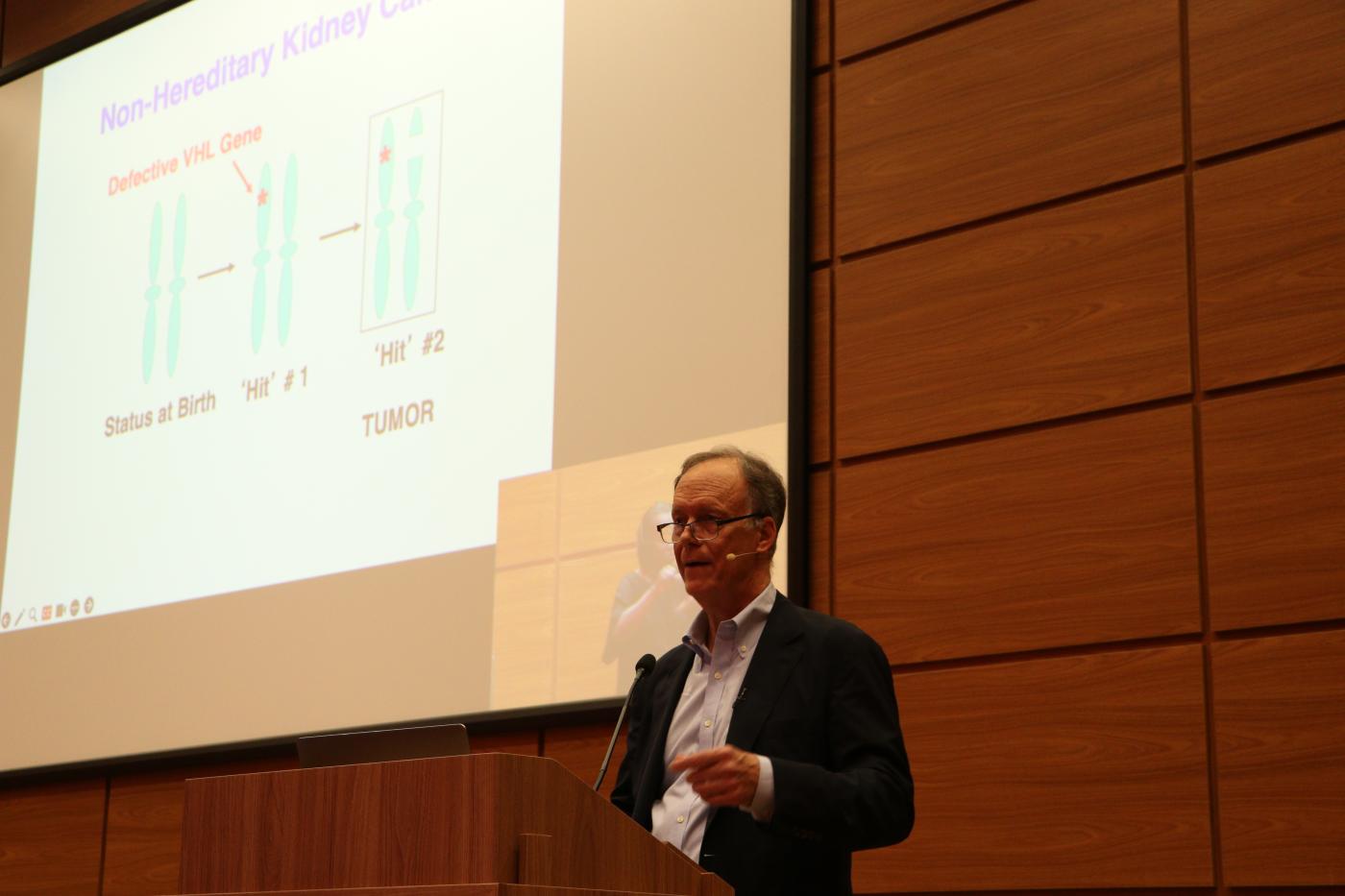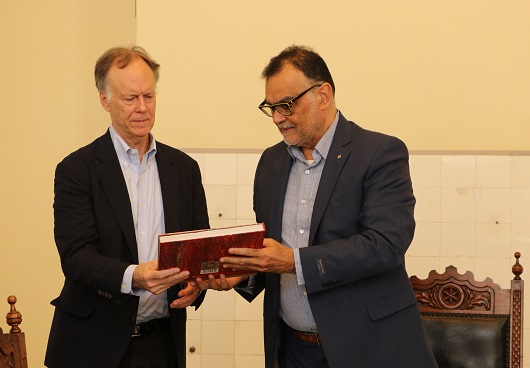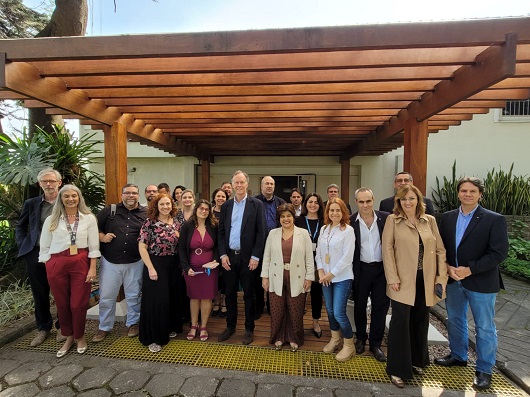Winner of the Nobel Prize in Medicine seeks to inspire young researchers in lecture at Fiocruz
06/09/2023
Cristina Azevedo (Fiocruz News Agency)
“Seek to surround yourself with people who are smarter and more talented than you are.” In front of an audience of researchers, students and employees of Fiocruz, William G. Kaelin Jr gave advice like this and spent an hour and a half telling the audience a little about his personal trajectory and his work – including the research that led him to receive the 2019 Nobel Prize in Medicine. His lecture How Mammalian Cells Sense and Respond to Oxygen (and My Unlikely Journey to Stockholm), at the Auditorium of the Immunobiological Technology Institute (Bio-Manguinhos/Fiocruz), is part of a Nobel Prize Inspiration Initiative (NPII) program aimed at encouraging young students and scientists and which, in partnership with AstraZeneca, brought Kaelin to Brazil.

William G. Kaelin Jr. spoke to an audience of students and researchers at Bio-Manguinhos Auditorium (photo: Peter Ilicciev)
Kaelin received the Nobel along with Peter Ratcliffe and Gregg Semenza for discovering how cells sense and adapt to oxygen availability – a discovery that paves the way for new treatments for cancer, anemia and other diseases. Professor of Medicine at Harvard University and researcher at the Dana-Farber Cancer Institute and Howard Hughes Medical Institute, he was received by the Foundation's president, Mario Moreira, at the Moorish Castle, as well as by vice presidents and members of the Executive Board. “To have you here is great for us to encourage our young researchers and students to become even more involved in research”, said Moreira to the Nobel laureate.
Accompanied by the vice-presidents of Production and Innovation in Health, Marco Krieger, of Environment, Healthcare and Health Promotion, Hermano Castro, of Education, Information and Communication, Cristiani Machado, of Research and Biological Collections, Maria de Lourdes Oliveira, by the executive director, Juliano Lima, in addition to other members of the Board, Moreira sought to present a little of the Foundation's work.
“What impressed me most about Fiocruz, including its wonderful history, was the fact that I saw that it ranges from basic research to production of vaccines. I cannot remember having visited another institution that had this breathtaking number of activities and impact", said Kaelin, who visited the Rare Works Library, where he could see the book “Formulações Médicas” [Medical Formulations], a manuscript work from 1703 by a Jesuit priest, and a book signed by Einstein.

Kaelin was welcomed by Mario Moreira at Moorish Castle (photo: Peter Ilicciev)
From average student to Nobel Prize winner
In the Bio-Manguinhos auditorium, Krieger thanked the NPII and AstraZeneca, highlighting the importance of Kaelin's visit from a scientific point of view as well as for his personal journey. Scientific chief officer at Nobel Media, Adam Smith explained that, for 30 years, the NPII has taken laureates around the world to inspire young talents. Executive Director of Corporate Relations, Regulatory Affairs and Diagnosis for Brazil at AstraZeneca, Jorge Mazzei thanked the NPII and Fiocruz for their partnership, recalling that the company has already helped to bring four laureates to Brazil, “who gathered a total audience of eight thousand people to see them”. Also at the opening table, the British Consul General in Rio de Janeiro, Anjoum Noorani, said it was inspiring not only to meet the Nobel laureate but to see himself in front of so many young students and researchers, also highlighting Fiocruz's role in the pandemic, helping to save lives.
Kaelin was able to present a little more of his career and his work. From his childhood, he highlighted an interest in toys such as a microscope (later donated to the Nobel Museum, along with his stethoscope and medical equipment) and a chemistry kit. Still, he revealed that he had been an average student until he came across a computer – one of the first installed in American schools – in 1974, which he defined as one of the moments that changed his life.
“I was born in 1957. If there was ever a good time to train scientists in the United States, that was it”, he said, recalling that satellites and spacecraft were beginning to be launched into space and that the American government was investing in science in the midst of the Cold War. Years later, a flyer he found at school caught his attention: 32 high school students across the country would be chosen to study math and computer science at the Florida Atlantic University (FAU) for eight weeks. Kaelin was one of them, and suddenly math had gained life, education that often seemed boring became stimulating, and the student soon discovered the importance of hanging out with more talented people. “It made me, after returning, more interested in studying, surrounding myself with smarter people, doing my homework, moving from the back to the front row in the classroom. And my grades jumped to A and A+”, he recalled, saying that he went on to study Medicine at Duke University.
The role of mentors
Even so, there were obstacles, such as discouragement due to projects that went wrong. Thus, Kaelin highlighted the role of mentors who encouraged him to continue, to work in the laboratory and even to conduct research on cancer. “If laboratory work is grueling, this might not be the right project for you”, he suggested. One of those mentors was David Livingstone, who invited him to work in his laboratory, which led to a successful postdoctoral fellowship, several papers, and further research into kidney cancer and the role of oxygen in tumors. “You need to love what you do every day and, if you are lucky, maybe one day you will win an award”, he said, to great applause, in the speech followed by a Q&A session.
Kaelin surrounded by Fiocruz researchers (photo: Cristina Azevedo)
Kaelin ended his visit to Fiocruz with a lunch with 18 Foundation researchers from different areas, in addition to Krieger and Lourdes, when he could answer more technical questions about his research. “We had a wonderful discussion with the group of researchers. It was impressive to see how well thought out the questions were. It was also a good opportunity to present my work to young researchers, who are the future of all of us”, he concluded.
For Fiocruz, Kaelin's name is now added to that of other Nobel laureates who visited the Foundation, such as Albert Einstein, Nobel Prize in Physics in 1921, and Alexander Fleming, Nobel Prize in Medicine in 1945, as well as Aaron Ciechanover (Chemistry, 2004), Martin Chalfie (Chemistry, 2008), Françoise Barre-Sinoussi and Luc Montagnier (Medicine, 2008) and Bruce Beutler (Medicine, 2011).


